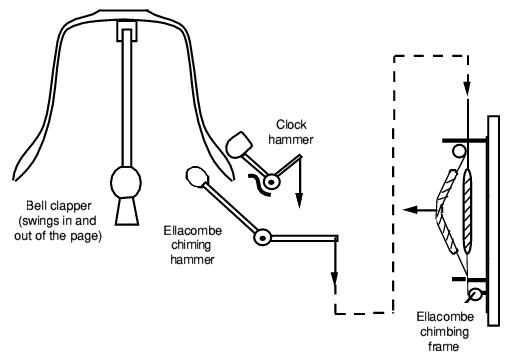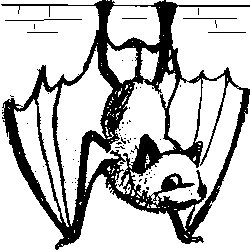 Typical striking arrangements
Typical striking arrangementsThe Tower Handbook
We have made many references to nuts and bolts above. You may be fully familiar with what follows, but we think it worth including for anyone who isn't. A nut is a square or hexagonal block of steel with a thread in its centre. It screws onto the corresponding thread on the bolt, which may be any length from an inch or so up to four or five feet in the case of tie bolts securing a frame.
Nuts suffer from two common problems:
In some cases there may be locknuts, ie a pair of nuts one above the other. They are used where there might be some movement that could work the nut loose. To secure a lock nut, run the lower nut down as far as possible and tighten it independently of the top one. Then hold the lower one firm with a spanner, run the upper one down and tighten it against the lower one, making sure the lower one does not turn.
Sometimes, especially on clapper staples, there is a castle nut instead of a pair of locknuts. This is a nut with castellations on one face, rather like the top of a rook in chess. You secure the nut by passing a split pin though the castellations of the nut and through a hole in the bolt (provided for the purpose). You may need to add washers so everything lines up.
Coach screws are massive screws with coarse threads and a square or hexagonal top for turning with a spanner. They are often used to anchor bearing plates or braces to timber frames. If you can't tighten one because it keeps turning, either the thread has worn or rusted away, or the hole in the timber has become enlarged. In either case, tightening will get you nowhere. If the thread has worn away try replacing it with a new one of the same size. If the hole is worn you can try to plug [254] it and refit the bolt. You could fit a larger screw but it might not go through the hole in the plate. You could replace it with a long bolt and nut going right through the timber. This means drilling the frame so don't do it lightly. Talk to the experts if in any doubt.
Slate or stone louvres are generally trouble free unless a crack develops. Wooden louvres are attached to the masonry by brackets and screws that can rust. Louvres have been known to fall into the bells while ringing so it's worth occasionally checking that they are firmly attached.
If you get rain blowing in through the louvres you could fasten some material over the affected ones to deflect the rain so it runs back out. This problem is more likely on the south or west of the tower because of the prevailing direction of high winds. It is virtually impossible to keep snow out in high winds unless you can completely close the openings on the windward side.
If pigeons are a problem, you can consider keeping them out with some form of netting. Wire netting was traditionally used, but heavy duty plastic mesh (as used for climbing plants) is durable and will not rust. The easiest place to attach it is on the inside with cable clips held by masonry pins. This keeps the birds out of the bell chamber, but they may still perch in the space between the louvres. So feathers will still blow in and filter down the rope guides, and the birds may still cause a nuisance with droppings below, eg outside the church door. Netting or other protection on the outside is beyond the scope of the DIY steeple keeper.
The most essential items are spanners that fit the nuts and bolts in your tower. You need open-ended ones (essential for square sections) and ring or socket spanners. Older installations will have imperial nuts and bolts. You may be able to get hold of Whitworth sizes, or find metric spanners that are a pretty good fit. If you have a timber frame with tie bolts you need a pair of spanners so that you can lock one end while tightening the other.
Adjustable spanners up to about 35mm (1.5") are useful, but make sure you adjust them to fit tightly every time you use them since a loose fit can damage the nut. If you apply excessive force to an adjustable spanner, it will strain the jaws and then it will never fit properly. Do not use stillson wrenches unless all else fails, since the teeth will damage the nut heads. If you have a very old installation with non standard size nuts made by the local blacksmith, you may have to use the adjustable. A screwdriver or two and a pair of pliers will probably complete your basic tool-kit for most general maintenance.
You will need other things depending on the type of installation you have, eg
The ringers are not usually responsible for maintaining the clock, but often have the job of winding it (presumably because they most often go up the tower). If you happen to notice a rusting linkage, hammers getting too near to bells or anything untoward contact the appropriate authority.
You may have other devices in your tower for chiming the bells. If they have separate bells, they will not have a direct effect on the ringing installation (but you may be expected to keep an eye on them). Often they operate on one or more of the bells hung for full circle ringing.
Maintaining the mechanisms themselves is largely straightforward. Make sure bearings are clean and greased, nuts are tight and that wires and levers are not fouled. The mechanisms themselves are best left to the specialists.
Your most likely concern is at the bell. These additional hammers always strike the side of the bell to avoid starting it swinging. Where they strike the bell they are in the path of the swinging bell (and often wheel). They must be kept clear and must not operate while the bells are ringing (or left up [255])
 Typical striking arrangements
Typical striking arrangements
There are two basic schemes:
 Contact the person in your local council responsible for bat preservation. Bats are a protected species and you may be required to have a survey to establish exactly where the bats are before undertaking any work that might disrupt them.
Contact the person in your local council responsible for bat preservation. Bats are a protected species and you may be required to have a survey to establish exactly where the bats are before undertaking any work that might disrupt them.
Get help if you are not certain about what to do, Most associations have people who can help with the practical side of towers and bells. They will help you whether or not you are a member. Ask your district secretary if you don't know the right person to contact. Names and addresses appear in your association report, or in The Ringing World Diary. Do not go to 'the chap down the road' unless you are sure he (or she) really is competent.
Currently hosted on jaharrison.me.uk